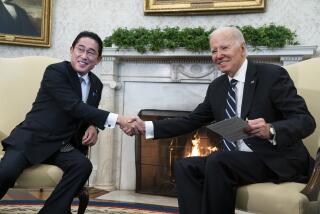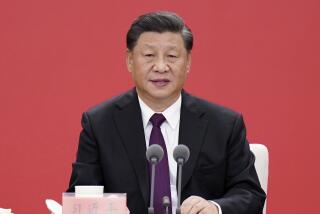Pacific Basin Shapes Next Trade World
SANTA BARBARA â Look beyond current U.S.-Japan trade tensions to see the extraordinary rise of Pacific trade and investment over the past two decades, perhaps the greatest economic success story of this century.
Starting with Japanâs âeconomic miracleâ of the â60s, the extraordinary growth figures of Korea, Taiwan and the countries in Southeast Asia symbolized a triumph of technology, modernization and hard work over traditional ideas of geography and some historical European assumptions. More than anything else, the demonstrable competence and creativity of Asians in business and technology--and here we include the belated modernization drive of the Peopleâs Republic of China--has upset three centuries worth of stored conventional wisdom about Western superiority in these areas.
This success story, however--not to mention the very concept of the Pacific Basin--embracing the East Asian countries, Australia and New Zealand, the Pacific islands and North America--is by no means an Asian matter alone nor is it purely economic. Now that gross national product growth figures have been coming down and trans-Pacific economic brawling becomes the order of the day, we would do well to remember the real significance of Pacific Basin community to its members. (Please see related interview with Henry A. Kissinger on Page 2.)
To argue, as some of our fashionable economists do, that the whole Pacific idea âis out,â now that the high growth has abated, is to throw out a pretty big baby along with the bath water.
To begin with, the primary factor in Pacific growth has been the United States. Development and booms in all the Pacific countries--Japan notably included--has been fueled not merely by the immense buying power of the free American marketplace, but by American exports, investments, education and ideas. The export and sharing of Americaâs intellectual properties over the past 30 years in itself has played a vital role in building Pacific prosperity. There is also a political side to the Pacific growth story. The peaceful conditions of good trading have been guaranteed by American power. Since Vietnam, the Pacific diplomacy of the United States has been conciliatory rather than coercive. Unlike the ill-fated SEATO (South East Asian Treaty Organization, in case you forgot) of the John Foster Dulles era, ASEAN--the Assn. of Southeast Asian Nations--was founded 20 years ago as a voluntary association of five equals--Indonesia, Malaysia, the Philippines, Singapore and Thailand--for mutual protection against military attack as much as for mutual economic development and modernization.
The ASEAN countries (now joined by Brunei) have a long way to go before becoming anything like an economic community. But they furnish a model for other developing nations, all the more striking for the sharp diversity of cultures and traditions represented.
Free-enterprise business has been the guiding principle of the Pacific Basin economies, even though often restricted by development-minded bureaucracies. Marxists and doctrinaire socialists have been conspicuous by their absence from the growth scenarios. Where rigid communist planning prevailed--as in North Korea, communist Vietnam and, until the late â70s, in the Peopleâs Republic of China--the consequent economic ossification has served as a living example of what not to do.
It would be wishful thinking of a high order to classify all the nations around the Pacific Rim as democracies. Varying degrees of authoritarianism exist among them, albeit mixed with democratic forms. Yet economic success has brought rising expectations with it, and these are in turn fueled by the pervasive and continuing educational and cultural influences coming from North America. All this has exerted its own pressure for greater political and social freedom.
Another political factor should be mentioned. For the past decade and a half, the three historic Pacific powers--Japan, China and the United States--have been at peace. More, they are cooperating (and also competing) in assisting the fitful but measurable modernization of the Peopleâs Republic of China.
The Soviet Union has at last shown signs of getting into the Pacific act. General Secretary Mikhail S. Gorbachevâs speech in Vladivostok last summer declared a desire to participate in Pacific trade and development. The change in attitude is surely the result of the Pacific communityâs visible progress.
There are at least six common denominators in that success. The first is the most obvious; modern advances in telecommunications and transportation have made once-vast oceanic distances shrink. This has in turn produced new attitudes toward trade and industry, many of them made in Tokyo. There are, for example, the Japanese concept of international marketing, the stress on a new âinformation societyâ and the location of heavy industries at communications centers rather than near the sources of raw materials.
Improved Pacific communications led also to a swift and quite irrepressible traffic in ideas and influences. It took many centuries, for example, for the idea of a Mediterranean world to take hold--best symbolized, perhaps, by the Greek/Phoenician alphabet and the old-fashioned sailing galley. The Pacific world, by contrast, is best symbolized by modern artifacts like jet airliners, TV screens and semiconductors. Inventions like these have been exploited with such bewildering speed that it is hard to comprehend how they erase conventional ideas of distance.
A second obvious factor in the economic takeoff of the Asian/Pacific countries has been their high rates of savings and investment. Even today Japanese families save about 17% of their annual incomes (as opposed to barely 5% in the United States); Singaporeans are forced to put almost 20% of their salaries into a compulsory savings plan. All of this leaves large sums available for capital investment.
Agricultural development is a third factor, growing alongside postwar industrialization. Through the decade of the â70s, for instance, food production in most of these countries increased by one-third.
Fourth, export-directed economies are the most convincing reason for Pacific success. Emerging countries around the Pacific--unlike many Third World countries elsewhere--have generally bet their futures on trade. The goal is a kind of self-perpetuating expansion, one countryâs economic growth helping others grow. The old Japanese economists used to call this the âflying geeseâ pattern of development, by which other countries follow the lead countryâs pace, at varying rates of speed.
Fifth, Pacific growth has been consistently led by the private sector. The most successful nations respect the free market. Nonetheless, most of the Asian countries, following Japanâs lead, have given their business sectors strong doses of government support and direction. Generally competent, dedicated technocrats have set long-range economic goals and priorities, with a degree of consensus between them and business leaders that Western societies would generally find difficult to attain.
Finally, and importantly, we have had general political stability in the region, at least over the past 15 years. What we call stability in some countries may seem more to us like repression. The combination, however, of risk-taking businessmen and strong central government, exemplified by Japanâs redoubtable Ministry of International Trade and Industry (MITI), has blazed the trail for a new kind of âConfucian capitalism.â
And now? After years of fruitless jawing over specifics--charities this week, metal baseball bats the next--the Congress of the United States is declaring war, firmly if blindly, on the privileged sanctuary of the Japanese domestic market. Even the Japanese, after 10 years of pretending that all is fairness, worry just a bit about what Peter Drucker calls their âadversarial tradingâ posture. As last yearâs prescient Maekawa Report noted, Japanâs current account surplus is basically linked to Japanâs economic structure. Korea and Taiwan, concerned about their own protectionism against American products, meanwhile wonder if they will ever be allowed to develop an even slightly favorable trade balance with Japan.
Now, many of the factors that created the Pacific Basinâs economic takeoff are working against themselves. High savings rates discourage consumption of imports. Spectacular agricultural growth for some countries means bad news for traditional commodity exporters elsewhere. The plan-rational economies of Japan and Korea are meeting unforeseen obstacles. And government changes in almost all Pacific countries are in the offing--with the outcome in, say, Korea and Indonesia by no means guaranteed to repeat the fortuitous happy ending of the post-Marcos change in the Philippines.
Is the Pacific âhypothesisâ going to explode the way some fashionable economists predict? By no means. The high growth may be leveling off--a quite understandable phenomenon--but it has meanwhile done very good things for the people of those Pacific countries. With it has come a growing cultural interchange with the United States, which now enjoys a cultural, educational and, in an odd way, economic primacy that could never have been gained by wars or pacts. A region once at perpetual war is now dedicated to peaceful trade and development. There are even signs that sterile Soviet surrogates in North Korea and Vietnam may start thinking in economic rather than military terms.
Of course Japan must now curb cultural protectionism. The United States must develop its own competitiveness, while continuing to insist on bigger but fairer Pacific trade; our national finances are as much hostage to Asian investors as their exports are to American consumers. It is complex, this new Pacific Basin economy, but its mood is up; member countries, overriding old racial and cultural barriers, are talking to each other now as they have never talked before.
More to Read
Inside the business of entertainment
The Wide Shot brings you news, analysis and insights on everything from streaming wars to production â and what it all means for the future.
You may occasionally receive promotional content from the Los Angeles Times.









